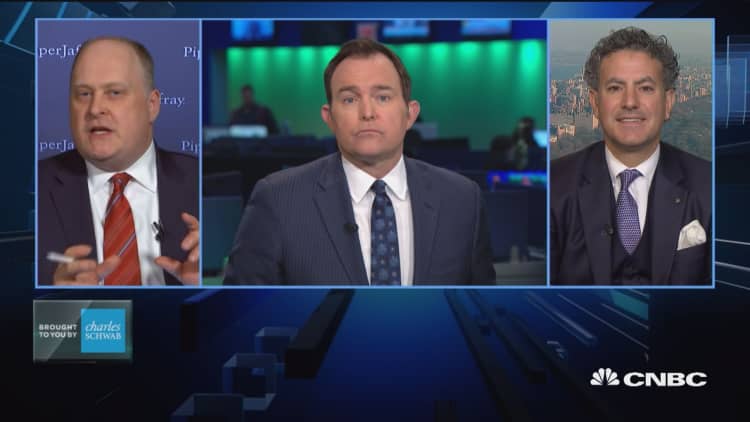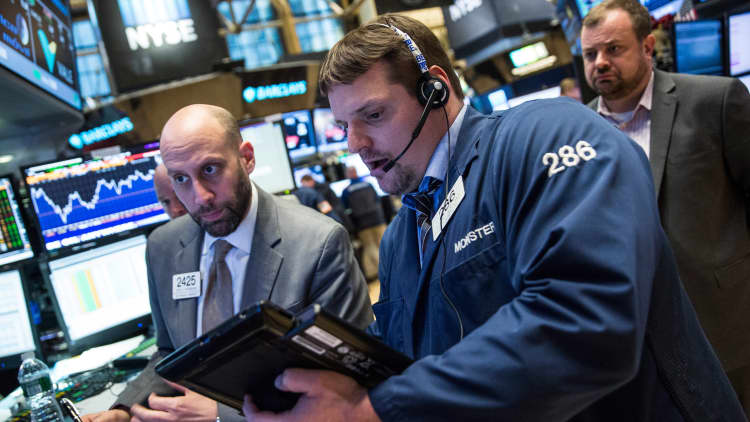
U.S. stocks closed sharply lower on Tuesday, falling for a second day as the first major sell-off of the new year intensified.
The Dow Jones industrial average dropped 362.59 points to finish at 26,076.89, with UnitedHealth as the biggest decliner. The 30-stock index also posted its biggest percentage decline since May. It fell 411.06 points at its session low.
The pulled back 1.1 percent to 2,822.43, with health care as the worst-performing sector. The index also snapped its longest stretch ever without back-to-back declines of at least half a percent. It also had its worst day since August
The Nasdaq composite fell 0.9 percent to close at 7,402.48.
"We've had a unilateral move higher [in stocks] to start things off and people are realizing this is not sustainable," said Art Hogan, chief market strategist at B. Riley FBR. "You're also seeing some cracks in the global story with interest rates rising."
The Dow fell 177 points on Monday, on the back of a rise in the 10-year treasury yield, raising concerns that higher interest rates could douse the bull market. The Dow, along with the S&P 500, posted its worst decline of the year on Monday.

Long-dated Treasury yields climbed further on Tuesday, with the U.S. 10-year Treasury yield trading near levels not seen since 2014, amid fears of higher inflation. The benchmark yield started the year trading around 2.4 percent.
Higher inflation could also lead central banks to tighten monetary policy faster than the market expects. Last week, Stifel strategist Barry Bannister predicted the Federal Reserve will cause a correction this quarter as it leads other central banks into tighter monetary policy.
The Fed kicked off its latest two-day monetary policy meeting on Tuesday. Market expectations for a rate hike are just 5.2 percent, according to the CME Group's FedWatch tool.
But Robert Pavlik, chief investment strategist at SlateStone Wealth, said he does not think this is the start of a major pullback. "I think people are looking for an excuse to sell," he said. "This is the first wave of selling we've seen in a while." Pavlik added this selling pressure could present a buying opportunity for investors who have cash on the sidelines.
The Cboe Volatility index (VIX), widely considered the best fear gauge in the stock market, rose to its highest level since August.
"It's interesting because the VIX started the month trading around 10, but has surged with stocks," said Jeff Chang, managing director at Cboe Vest. "Usually, you don't see that. ... A central explanation for this could be investors are looking to add some hedging to their portfolios" as stocks continue to rise.
Shares of UnitedHealth were the worst performers on the Dow, falling 4.4 percent. UnitedHealth fell after Amazon, J.P. Morgan Chase and Berkshire Hathaway announced plans to partner on ways to cut health-care costs.
As of Monday's close, health care was on pace for its best monthly performance since Oct. 1999 when it gained 10.98 percent. On Tuesday, the sector fell 2.1 percent, notching its biggest onde-day decline since October.
In economic news, consumer confidence rose to 125.4 in January as Americans expect the U.S. economic momentum from 2017 to carry over into the new year.
Elsewhere, President Donald Trump is expected to deliver his State of the Union address on Tuesday night.
The address will come after the administration announced Monday that it wouldn't immediately inflict further sanctions on Russia under a new law designed to punish Moscow's alleged meddling in the U.S. 2016 election. The administration stated that the measure was already having an impact on companies in Russia.
—CNBC's Gina Francolla and Chris Hayes contributed to this report.
Clarification: This story has been updated to reflect the Dow posted its biggest percentage decline since May.







